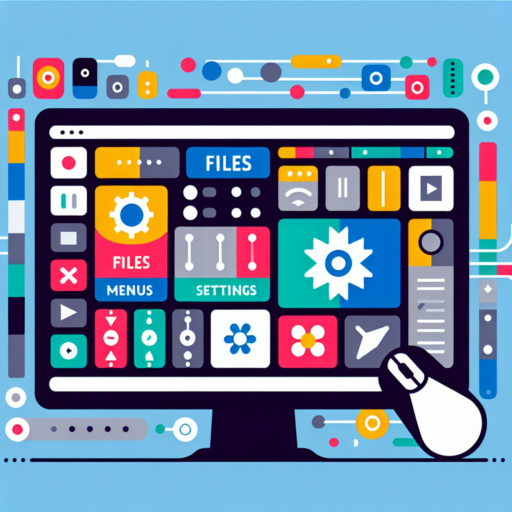What is a System Menu?
The System Menu is a pivotal component within most operating systems and electronic devices. It serves as the central hub for accessing a wide variety of system settings, configurations, and information. This interface allows users to adjust settings such as display resolution, system time, and device connectivity options, tailoring the user experience to their specific needs and preferences.
Typically, the System Menu can be accessed through a series of straightforward steps, varying slightly depending on the operating system or device in question. It’s designed with user accessibility in mind, ensuring that even those with minimal technical knowledge can navigate through options efficiently. From adjusting sound levels to managing connected devices, the System Menu encompasses a broad range of functionality vital for the optimal operation of any system.
Furthermore, beyond basic settings and adjustments, the System Menu often includes advanced system tools and utilities. These tools can be used for tasks such as system backups, security configurations, and network setup. It essentially acts as a gateway, providing users access to deep-seated system functionalities that help in maintaining the health and efficiency of the device or operating system.
The Evolution of System Menu Interfaces
The journey through the evolution of system menu interfaces reveals a fascinating story of innovation and user-centered design. From the humble beginnings of command-line interfaces to the sophisticated graphical user interfaces (GUIs) we interact with today, each step in this evolution has significantly impacted how users engage with computing devices.
From Command-Line to Graphical User Interfaces
Initially, system menu interfaces were predominantly command-line-based, requiring users to memorize and enter specific commands. This method was efficient for skilled users but posed a steep learning curve for novices. The advent of graphical user interfaces in the 1980s transformed the user experience by introducing visual elements such as windows, icons, menus, and pointers (WIMP), which allowed for more intuitive interaction with computers.
Touch Interfaces and Beyond
The early 2000s marked a significant shift with the introduction of touch interfaces, leading to the widespread adoption of smartphones and tablets. These devices embraced finger-based navigation, offering a direct and tactile way to interact with system menus and applications. This era also saw the rise of voice-activated assistants and gesture-controlled menus, further expanding the ways users could interact with their devices.
- Command-Line Interfaces: Efficient for experts, challenging for beginners
- Graphical User Interfaces: Introduced intuitive visual elements
- Touch Interfaces: Enabled direct, tactile interactions
- Voice and Gesture Controls: Offered innovative ways to navigate menus
How to Navigate and Customize Your System Menu
Navigating and customizing your system menu is crucial for enhancing your computer’s usability and streamlining your workflow. Whether you’re a newcomer or an experienced user, understanding how to tailor your system menu can significantly boost your productivity. This guide will delve into the basic strategies and tips to help you master your system’s navigation and customization.
Understanding Your System Menu’s Default Layout
The first step to customization is to familiarize yourself with the default layout of your system menu. Typically, the system menu is designed with intuitiveness in mind, providing easy access to your computer’s most essential features. However, the placement of these features might not align with your personal or professional needs. By exploring the default setup, you can identify which elements you frequently use and which ones you can reorganize or remove.
Personalizing the Look and Functionality
Personalizing your system menu involves two main aspects: appearance and functionality. To adjust the appearance, look for settings that allow you to change the menu’s theme, fonts, and colors. This can make your system menu visually pleasing and reduce eye strain. Regarding functionality, focus on rearranging or adding shortcuts to your most used applications or settings. This might include pinning software to the top of the menu or removing unnecessary icons that clutter your space.
Remember, navigating and customizing your system menu should aim to make your interaction with your computer more efficient and enjoyable. By dedicating some time to understand and adjust the layout to suit your needs, you can create a highly personalized experience that enhances your productivity and reflects your personal style.
Common Issues and Fixes for System Menus
System menus are essential components of user interfaces, providing easy access to various functionalities. However, users often encounter issues that can range from minor annoyances to significant obstacles in usability. Identifying and addressing these common problems can greatly enhance the user experience.
Unresponsive or Slow Menus
One frequent issue is unresponsiveness or slow performance of system menus. This can be caused by a lack of system resources, outdated hardware, or software conflicts. To fix this, users can try closing unnecessary applications to free up system resources, updating their operating system and hardware drivers, or performing a system cleanup and optimization.
Inconsistent or Erratic Behavior
Another problem is the inconsistent or erratic behavior of system menus, where menus might not appear as expected or commands do not produce the expected outcomes. This could be due to software bugs or corrupt system files. Running a system file checker tool, updating the software to the latest version, or resetting the system settings to default could resolve these issues.
Difficulty in Navigation
Users might also face difficulty in navigating through system menus, especially if they are complex or poorly organized. Enhancing menu readability and ease of access can be achieved through customization options, such as adjusting the size and display settings of menus, or reorganizing menu items for better logical grouping.
Comparing System Menus Across Different Operating Systems
When it comes to navigating the digital realm, the system menu serves as our roadmap, subtly guiding each action with its layout and options. Different operating systems (OS), from Windows to macOS, and Linux, offer distinct experiences through their system menus, reflecting their unique approach to user friendliness and functionality. The design, accessibility, and the options provided within these menus not only cater to specific user needs but also highlight the philosophical differences between the operating systems themselves.
The Windows OS has long been praised for its intuitiveness. Its Start Menu, a cornerstone of user navigation since Windows 95, seamlessly integrates both traditional desktop applications and modern apps. Over the years, this system menu has evolved, with Windows 10 and 11 exemplifying a perfect blend of function and form. The integration of live tiles, a search bar, and a dynamic list of frequently used apps make it a potent tool for everyday tasks. However, the contrast becomes evident when placed side by side with macOS’s Finder and Dock, which prioritize a more minimalist and intuitive design, focusing heavily on ease of access and a less cluttered user interface.
On the other hand, Linux distributions offer an entirely different flavor with their system menus, which can vary significantly between distros. The GNOME desktop environment, for example, takes a simplistic approach akin to macOS, yet with a greater degree of customization. KDE Plasma, in contrast, offers a more traditional, Windows-like experience, but with a heightened level of control over the desktop’s look and functionality. This diversity underlines Linux’s commitment to providing a highly customizable interface, catering to a wide range of preferences and usability standards.
No se han encontrado productos.
Enhancing Your Workflow with System Menu Shortcuts
Discovering and implementing system menu shortcuts can significantly optimize your daily computer use, making repetitive tasks quicker and more efficient. Whether you are a professional looking to streamline your workflow or a casual user eager to navigate your system with more ease, understanding these shortcuts is invaluable. From opening applications to managing system settings, the potential to speed up your workflow is tremendous.
Key Shortcuts to Elevate Productivity
Mastering key combinations can transform your approach to computer work, enabling you to bypass lengthy navigation steps. For example, shortcuts like Ctrl+C for copying and Ctrl+V for pasting are universally recognized timesavers. Beyond these, learning shortcuts specific to your operating system can unlock new levels of efficiency. Windows users, for instance, can benefit from Windows key + D to quickly show the desktop, while Mac users might find Command + Option + Esc crucial for force quitting unresponsive applications.
Customizing Shortcuts for Personal Efficiency
While many shortcuts are built into the system, taking the time to customize shortcuts that fit your specific workflow can yield even greater productivity gains. By tailoring shortcuts to the applications and functions you use most, you effectively minimize task completion time. This customization can typically be done within the settings of your operating system or through third-party applications designed to enhance user experience.
Customization Tools and Apps for Your System Menu
When it comes to personalizing your computing experience, the system menu stands out as a focal point of interaction. It’s where you access all your applications, settings, and utilities. Thanks to a plethora of customization tools and apps, tailoring this essential interface to your preferences and needs has never been easier. These tools unlock a new realm of possibilities, from aesthetic enhancements to functional tweaks, ensuring that your system menu not only looks good but works in a way that best suits your workflow.
Among the sea of options, certain applications have risen to the top for their reliability, ease of use, and the extensive customization features they offer. These range from simple skinning apps that change the visual appeal of your system menu to more sophisticated software that allows you to overhaul the menu’s architecture. For instance, tools like Rainmeter and Classic Shell have gained popularity for their ability to make significant alterations without impacting system performance. They empower users to create a system menu that is both unique and efficient, blending form with function.
Exploring Customization Features
Exploring the customization features of these tools reveals a world where almost everything is adjustable. Users can modify icons, menu layouts, and even integrate live widgets directly into their system menu. This level of customization ensures your system menu not only aligns with your aesthetic preferences but also enhances your productivity by streamlining your access to the tools and applications you use most. Furthermore, many of these apps come with user-friendly interfaces and support communities that help you navigate through the customization process, making it accessible even for those who might not be tech-savvy.
The Future of System Menus: Trends and Predictions
The landscape of user interface design, especially in the realm of system menus, is undergoing rapid transformation. As technology evolves, the way we interact with software systems is poised for significant change. This evolution is driven by a combination of user demand for more intuitive experiences and advancements in technology that enable these improvements.
Integration of Voice Control and AI
One of the most exciting trends is the increasing integration of voice control and artificial intelligence (AI) within system menus. These technologies are making it possible for users to navigate systems more efficiently and in a more personalized manner. With AI’s ability to learn and adapt to individual user preferences, system menus can offer more relevant options and actions, significantly enhancing the user experience. Voice control adds a layer of convenience, allowing for hands-free operation which is particularly beneficial for accessibility and multi-tasking.
Augmented Reality and Virtual Interfaces
Augmented reality (AR) and virtual reality (VR) technologies are set to redefine the concept of system menus altogether. Instead of navigating through traditional linear menus, users could interact with a three-dimensional space, selecting options and commands in a more immersive and intuitive way. This could spell the end of static menus as we know them, replaced by dynamic, customizable environments that respond to each user’s unique needs and preferences.
The move towards more personal and immersive system menus reflects a broader trend in technology towards personalization and efficiency. As we look to the future, it’s clear that the interfaces through which we interact with our devices will continue to become more sophisticated, predictive, and adaptable to our individual needs.
Top Tips for Efficient System Menu Management
Mastering efficient system menu management can transform the usability and efficiency of any software or system. It’s all about creating a seamless user experience, where users can navigate and access features without unnecessary hassle. The key lies in a well-structured and intuitive menu design. Below, we delve into essential strategies that can lead to more organized and user-friendly system menus.
Streamline Navigation
At the heart of effective system menu management is streamlined navigation. This involves eliminating redundant steps and ensuring that all menu items are easily accessible. Consider grouping related functions together under a single menu heading to reduce clutter and simplify navigation. Use clear and descriptive labels for each menu item to enhance understandability, allowing users to find what they need without guesswork.
Adopt Responsive Design
In today’s multi-device environment, adopting a responsive menu design is a must. A well-designed responsive menu adapts to different screen sizes and orientations, providing an optimal viewing experience across all devices. Incorporate collapsible menus and adjustable text sizes to improve accessibility and readability, ensuring that your system menu is effortlessly navigable on smartphones, tablets, and desktops alike.
Implementing these tips into your system menu design can significantly improve how users interact with your software. Focus on simplifying navigation, grouping related options, and ensuring responsiveness to meet the needs of a diverse user base. By attentively managing your system menus, you can create a more intuitive and efficient user experience.
Security Best Practices for Your System Menu
Securing your system menu is crucial in the modern digital age, where threats can emerge from any direction. Implementing security best practices ensures that your systems remain robust against unauthorized access and potential breaches. While the landscape of cybersecurity evolves, some foundational practices stand as pillars for protecting your system menu.
Regularly Update and Patch Your Systems
One of the foremost steps in securing your system menu is to regularly apply updates and patches. Manufacturers and software developers frequently release these to fix vulnerabilities that could be exploited by attackers. Ensuring that your system runs the latest version of its software minimizes the risk of security loopholes being exploited.
Implement Strong Access Control Measures
Limiting access to your system menu is a critical component of its security. Implementing strong access control measures, like two-factor authentication (2FA), can significantly reduce the chances of unauthorized access. It’s essential to manage user permissions diligently, granting access strictly based on the necessity for their role, thereby adhering to the principle of least privilege.
Securing your system menu is an ongoing process that requires constant vigilance and adaptation to new threats. By focusing on these best practices, organizations can ensure a higher level of security, safeguarding their data and systems from potential breaches. While these strategies form the foundation of system menu security, it’s vital to stay informed about new threats and continuously evolve your security measures.




